
Wahoo has just announced their latest generation KICKR, now in its 5th iteration. This new unit adds compressing feet to reduce vibrations on hard floors as well as slightly increase motion. It also eliminates the need for calibration by adding a new zero-calibration algorithm, as well as increasing an accuracy claim to +/- 1% (from +/- 2%). Further, it adds a wired connectivity option for a future accessory, to allow direct connection to your home network (potentially eliminating dropout issues for some people).
As with most new KICKR editions, the changes are rarely sweeping in nature – and this holds true this time as well. Wahoo tends to make more minor year after year updates, though did skip last year to instead launch the KICKR Bike.
I’ve been riding the new KICKR V5 (2020) for a while now, so I’ve got plenty of thoughts and data on how well it works, and where it might need just a bit more polish. Simply scroll down, or hit the big red play button below to get started.
[Big red button coming momentarily, hurry up interwebs!]
Note that as usual I’ll send back this media loaner KICKR here back to Wahoo shortly and go out and get my own to add to my ever growing KICKR collection. You can help support the site by hitting up the links at the end of the post. With that – let’s dive into it!
What’s New:

From across the room, the KICKR 2020 doesn’t look like a major upgrade. Here’s what’s changed:
– New compressing AXIS feet system to give slightly more motion (up to 5%), and quieter on harder floors
– New KICKR Direct Connect wired option for connectivity (with to be announced accessory)
– New zero-calibration software algorithm
– Increases claimed accuracy to +/- 1% (from +/- 2%)
And…that’s about it. Ultimately, this is at present a very minor update to the KICKR, though, the wired option might be interesting for some people having challenges with connectivity in crowded buildings (signal-wise). Unfortunately, at this time the accessory dongle for that network connectivity isn’t available yet (more on that later).
On the zero calibration design, this is actually interesting for both users and racing. Up until now, one should occasionally calibrate (spin-down), their KICKR, especially if the temperature has changed substantially – such as in a garage. Else, it might not be accurate. Additionally, existing KICKR’s were relatively easy to tweak the accuracy to enable cheating. With the KICKR V5, a zero-calibration design there’s no longer a reason to calibrate.
While Wahoo allows you to calibrate, it’s mostly there as a pacification for some apps that might require it. And yes, the KICKR will technically ‘accept’ that calibration command and even slightly adjust. But like a friend receiving an unwanted present, a few minutes later it’ll quietly discard that calibration value resent and self-calibrate itself back to normal. This effectively removes the ability for someone to willfully cheat the calibration values for races.
Finally, there’s the AXIS feet. These feet in theory give more cushion and allow a tiny bit of roll. In practice, I haven’t found that to be the case – at least with a trainer mat. There’s zero feeling of difference (even using the smallest/most cushion feet). However, on concrete (no mat), you’ll effectively get the same amount of cushion as a mat would provide. It also probably provides a slight bit of vibration dampening on certain flooring with sensitive neighbors, but that’s hard for me to test. Again, more on the feet later.

As far as all the reliability issues of the KICKR & KICKR CORE of yesteryear, Wahoo says that they formed an internal dedicated quality team in Atlanta (HQ) and each of their factories, and then added additional processing/engineering checks as a result. They also say they track stats in far more detail in the past. The changes from those efforts were made as running changes into the KICKR18/CORE and roughly peaked (change-wise) around a year ago (Summer 2019). Wahoo says there’s no changes quality-wise between a KICKR18 produced more recently (such as early this year) and the KICKR V5/2020. Ultimately, there’s little I can do from a test standpoint except wait and see on this one. Fwiw, my unit hasn’t broken yet in the three plus weeks I’ve had it.
Oh, and just as a quick recap, here’s the general overall specs:
– Dual ANT+/Bluetooth Smart support, including ANT+ FE-C, plus power/speed/cadence broadcasting
– Axle Compatibility: 130 & 135mm quick release, 142x12mm & 148x12mm thru-axle
– 11-speed cassette included
– Compatibility for 8, 9, 10, 11sp cassettes (12-speed cassette compatible with XD/XDR adapter)
– Max 20% incline
– Max 2,200w supported resistance (at 40KPH)
– Power accuracy claim of +/- 1%
– Requires power cable/be plugged in
With that – there’s all you need to know about the KICKR5 in one little section. Pricing stays the same as the past ($ 1,199), and starts shipping today.
Unboxing:

This years KICKR box looks…well…almost like the last edition KICKR box. Except now it’s black and white instead of gray and white. On the top panel you’ll see a listing of what’s new:

And on the back there’s various tidbits on features:

While the box I received claims it has an electromagnetic design (that would make it akin to the KICKR Bike and Tacx NEO series), that actually isn’t exactly the case. At least if one uses the fairly industry agreed upon terms of what that actually means. Normally (and including how Wahoo has historically used it), that would apply to the KICKR Bike, Tacx NEO Series, and Wattbike ATOM 2020. These designs largely basically eliminate internal belts and use a series of magnetic coils instead of a physical flywheel.
In my call with Wahoo about this, they agree that the term probably isn’t correct in this usage. While the KICKR does have magnets, and does have electricity, nobody in the indoor trainer industry would call it an electromagnetic design/flywheel.
Moving along, after dumping out the contents of the box, you’ll find yourself here:

It’s nice and tidy, and works at keeping everything from getting dorked up. Here’s all the parts on a table, properly aligned:

Inside you’ve got two sets of extra AXIS feet (one set is already installed on the KICKR), each set has a different thickness/flex to it.

Then you’ve got two paper manuals you’ll likely never read (though, they do tell you about the thickness).

Then there’s the stickers. These are clutch (more on why in a few):

After that there’s the thru-axle adapters and disc brake clamper keeper:

And the power cable/block.

Oh, and of course the trainer itself. Don’t worry, you’ll see plenty of photos of that thing by time we’re done with this review. Note though that the 11-speed cassette is pre-installed on it.

And, a closer look at the model tag underneath it, the official KICKR name here is WFBKTR120 – with the 20 standing for year 2020:

With that, let’s get it setup and talk the basics.
The Basics:

To begin you’ll plop the KICKR down on your trainer mat and open up its legs. You’ll do that by pressing down on the little blue leg locks, which then allow the two side legs to open up. You can close it for easier storage/transport.

You can adjust the feet height too (but more on the AXIS feet in a moment), if you have uneven floors. Next, depending on your bike frame you may want to raise the KICKR up slightly so that it sits level. In my case, I brought it up slightly.

After that, go ahead and plug it in. Now, at some point after the KICKR18 launched, Wahoo re-did the power supply to include ‘Wahoo Fitness’ on it (no trainer company, including Wahoo, has done this until this point). That’s handy if you’ve got multiple trainers around.

But, I like adding stickers to power supplies so I can see them from far across the room (or, just behind me while on the trainer). So, I took the smaller Wahoo KICKR sticker and stuck it on the top of the power supply:

Once powered on, you’ll see status lights at the top of the trainer, these indicate power as well as ANT+ & Bluetooth Smart connectivity:

Next, go ahead and toss your bike on. Given this is a direct drive trainer, that’ll mean removing the rear wheel and affixing it directly on the cassette:

You can choose whether or not to use a front wheel-block. You don’t need one, though I personally like it as it keeps my wheel from wobbling around aimlessly.
Alternatively, the KICKR V5 is compatible with the KICKR CLIMB, so you can connect/pair that up too, which will simulate the gradient of your route, moving your bike up and down throughout the course:

But…what about those AXIS feet? Well, there’s technically three sets of feet, with one foot per leg (the middle strut has a non-removable AXIS foot built into it). Here’s all three feet (in black) laid out, plus the mounting hardware for the left/right sides:
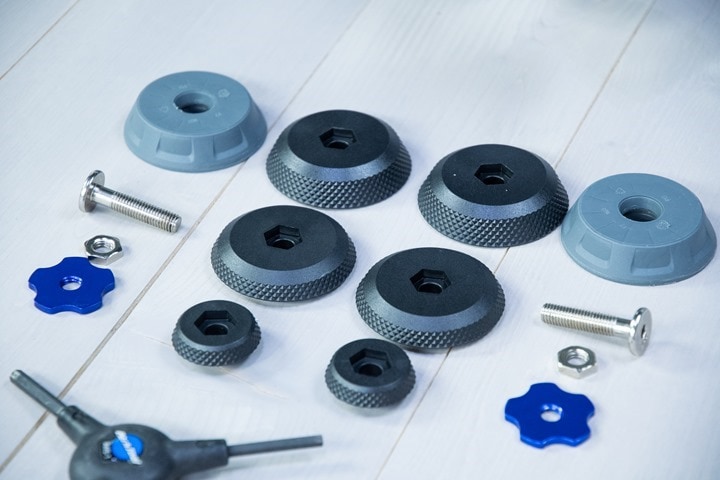
As you can see from the manual that you didn’t read, the three sets of feet align to three different resistance levels, which would be most applicable based on rider weight. I tried all, though did multiple full rides on the smallest and largest feet.

Looking at mounting, the feet spin off and then are disassembled with a simple hex wrench. It takes just a few seconds to do/change.
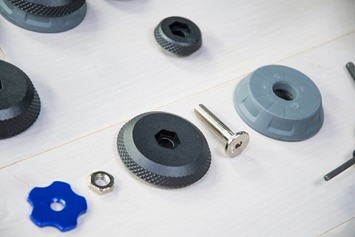
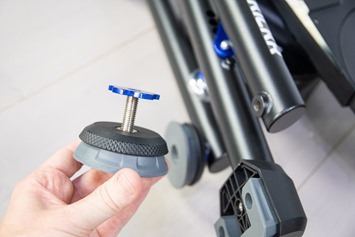
Here’s what a mounted foot looks like up close:
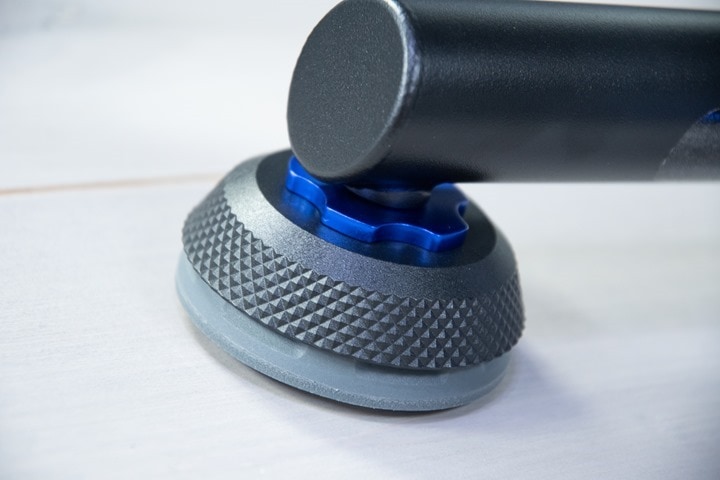
The feet are designed to give up to 5* extra movement/sway side to side. The main idea here is less about feeling like outside motion (such that a rocker plate would provide), and more about giving a little bit more sway that helps in longer trainer sessions by allowing your butt to make micro adjustments on the saddle (as it would outside). Also, the feet help dampen vibrations on harder surfaces, for those that might need that (such as in some apartments)
So, does it actually make any difference to ride feel? In short, not really. At least not on a trainer mat – which Wahoo kinda seemed to agree with on the call I had with them. The trainer mat will already give you more cushion than this well .However, they did note (correctly) that you’ll feel slightly more movement on a hard surface, like concrete.


And indeed, you can see exactly that comparison of movement in my full video at the top of the post, side by side.
Note that the AXIS feet will also be sold separately, and will be compatible with all existing Wahoo KICKR trainers (but not CORE/SNAP, since that’s a different leg design). So, if you do have an older unit and want to reduce vibrations, that may be an option. They’re $ 79.
With all that said, let’s start riding. Given the KICKR is a smart trainer, it’ll change resistance automatically in a few different ways, primarily driven by different applications/methods. But most of this all boils down to two core methods:
ERG Mode: Setting a specific power level – i.e., 205w. In this mode, no matter what gearing you use, the trainer will simply stay at 205w (or whatever you set it to).
Simulation (SIM) Mode: Simulating a specific outdoor grade – i.e., 12% incline. In this mode, it’s just like outdoors in that you can change your gearing to make it easier or harder. Wattage is not hard-set, only incline levels.
In the case of simulation (aka slope) mode, the KICKR V5 can simulate from 0% to 20% incline – the same as the KICKR 2018. While other trainers can simulate above 20% these days (including ones quite a bit cheaper than the KICKR), I continue to question how many people actually want to ride such a gradient. Just last weekend I did an actual outside road where the grade topped out at 17%. There’s no fun in doing that, let alone a 24% incline that some trainers can simulate.
And atop that, there’s little reason most of this matters if you use the defaults in Zwift, because it automatically halves the values anyway. A 10% grade feels like a 5% grade. You need to change the ‘Trainer Difficulty’ level to 100% in order to feel it (and most people don’t bother to). Where it can matter though is at low-speed high wattage climbs up those 12% or beyond ascents.
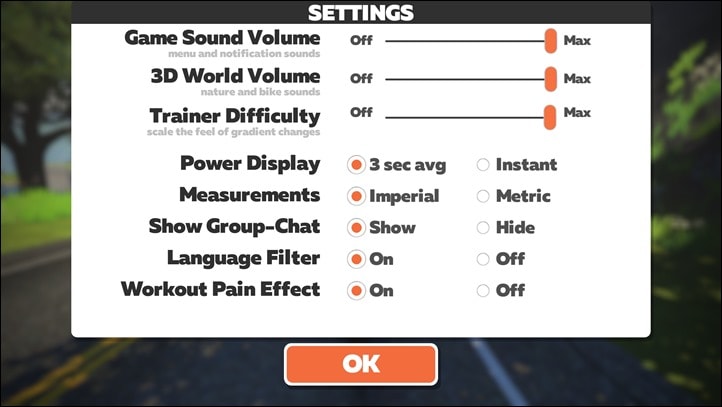
The second mode the trainer has is ERG mode. In that case, the company claims up to 2,200w of resistance at 40KPH. Although, realistically, you don’t care about that. I can only barely (maybe) break 1,000w for a second or two, and even most front of the non-pro pack cyclists aren’t going to top 1,800w. The pros would only be just a bit beyond that. Said differently: Peak numbers in this competition don’t matter. Instead, what matters is actually a harder metric to make clear – which is the ability to simulate high grades and lower speeds (especially if you’re a heavier cyclist).
One core test I do with all trainers though is responsiveness: How quickly does it respond to ERG mode changes? I typically do that with my 30×30 test via TrainerRoad, though it doesn’t really matter what method you use as long as you’re looking at big shifts in wattage:

Now, I dive into all the nuances of this later on in the accuracy section, specifically including my 30×30 test via TrainerRoad, though it doesn’t really matter what method you use as long as you’re looking at big shifts in wattage.
So what about road feel and noise?
Like I always say – for me personally, it’s hard to separate the fact that I’m riding indoors from outdoors. It’s still a trainer, and I’m still looking at a wall in front of me. My brain can only turn off so much of that. Still, much of the road-like feel is driven by the flywheel, and be it physical or virtual, flywheel sizes tend to be measured in weight. This impacts inertia and how it feels – primarily when you accelerate or otherwise change acceleration (such as briefly coasting).
All that prefacing done, the KICKR V5 feels identical to the KICKR2018, because…well…nothing has changed there. The flywheel is identical here. And in terms of peoples happiness level with the KICKR2018, everyone is largely pretty happy there in terms of road-feel. Given this is the same, I’m just as happy here as before. It’s smooth when it needs to be smooth, and ramps up (and down) correctly as you accelerate.

And as for sound? It’s essentially silent – just like the KICKR18. The only thing you’re going to hear is your drivetrain interfacing with the cassette. The trainer itself doesn’t make any noises, but your own bike will. By and large that sound level will vary based on how well you maintain your drivetrain. The cleaner and more well maintained, the quieter the entire trainer setup will be. I include audio snippets within the video at the top.
Ok, with all the basics out of the way, let’s talk app compatibility.
App Compatibility:

The Wahoo KICKR set the standard on trainer + app integration years ago when it was first introduced, but that’s actually less the case today than it was nearly a decade ago. Sure, virtually every app out there is compatible with the Wahoo KICKR series one way or another, but that doesn’t mean Wahoo follows all the industry norms today.
As such, the Wahoo KICKR V5 actually isn’t the most ‘universally compatible’ trainer these days. That’s because Wahoo has yet to implement the industry standard Bluetooth Smart FTMS trainer control protocol. But as with the KICKR 2018, that’s more of a technicality than anything, because as I noted – every app already supports Wahoo’s own trainer control standard over Bluetooth Smart anyway. So from an end user standpoint it has no meaningful impact to you.
In any case, the Wahoo KICKR V5 supports the following protocol transmission standards:
ANT+ FE-C Control: This is for controlling the trainer via ANT+ from apps and head units, and includes speed/cadence data. Read tons about it here.
ANT+ Power Meter Profile: This broadcasts as a standard ANT+ power meter, with speed and cadence baked in as well.
ANT+ Legacy Wahoo Trainer Control: Some older apps might still use this to control the Wahoo KICKR, it’s what Wahoo first started out on, but today most apps would use the FE-C variant.
Bluetooth Smart Wahoo Trainer Control: This is Wahoo’s private method of controlling trainers, and includes speed/cadence data.
Bluetooth Smart Power Meter Profile: This broadcasts as a standard BLE power meter with speed and cadence data.
It DOES NOT however, support these protocols (which trainers from Tacx and Elite do support):
ANT+ Speed/Cadence Profile: This broadcasts your speed and cadence as a standard ANT+ Speed/Cadence combo sensor. Wahoo doesn’t do this for any trainers.
Bluetooth Smart Speed/Cadence Profile: This broadcasts your speed and cadence as a standard BLE combo Speed/Cadence sensor. Wahoo doesn’t do this for any trainers.
Bluetooth Smart FTMS: This follows the industry standard Bluetooth Smart FTMS control, which is basically the Bluetooth variant of ANT+ FE-C for controlling trainers. Wahoo doesn’t do this yet.
So basically, the only meaningful takeaway of the above is that you can’t pair it with apps that only support proper FTMS, but I’m not aware of any major (or even minor) app that doesn’t support Wahoo trainers own propriety Bluetooth Smart implementation.
In the above, you’ll note there’s cadence data baked into the various streams, Wahoo started doing this a year ago with a Sumer 2019 firmware update to the KICKR 2018 and KICKR CORE. That’s handy if you’re connecting to Zwift on an Apple TV, due to Apple TV’s two concurrent Bluetooth Smart sensor limitation (plus the Apple TV remote). This means you can pair the trainer and get power/cadence/control, while also pairing up a heart rate strap.

Now, before we start pairing apps – you’ll notice I haven’t yet mentioned that wired port. Technically it’s an RJ11 port (aka, telephone jack port). However, you can’t just plug that into a 14.4 modem and dial-in Zwift. Instead, you’ll need to purchase a separate accessory adapter that’ll connect from that RJ11 port into RJ45 (Ethernet). Said adapter isn’t yet available, nor are there any apps compatible with it. Wahoo says they’re hoping to have this available by the end of the year, and while exact pricing isn’t yet decided upon – Wahoo says their aiming “for sure” to be less than $ 100USD.

The idea behind it is that with said #donglelife adapter, you’d be able to connect the KICKR straight into your home network, potentially avoiding any ANT+/Bluetooth Smart interference issues. In talks with app partners thus far, the KICKR would then be picked up by your app on the same network.
As for not just putting the darn ethernet port into the KICKR to begin with (rather than putting a port to put a dongle to a port), it sounds like this was more of a ease of manufacturing item up front to make timelines for this product launch. Here’s to hoping down the road that evaporates. Still, this will be up to individual apps to actually implement. One might remember that Kinetic implemented a dedicated USB connection port in their Kinetic Smart control trainers years ago…and heard nothing but silence from Zwift on using it.
Below, RJ45 (Ethernet) in yellow, RJ11 (telephone-style) in black.
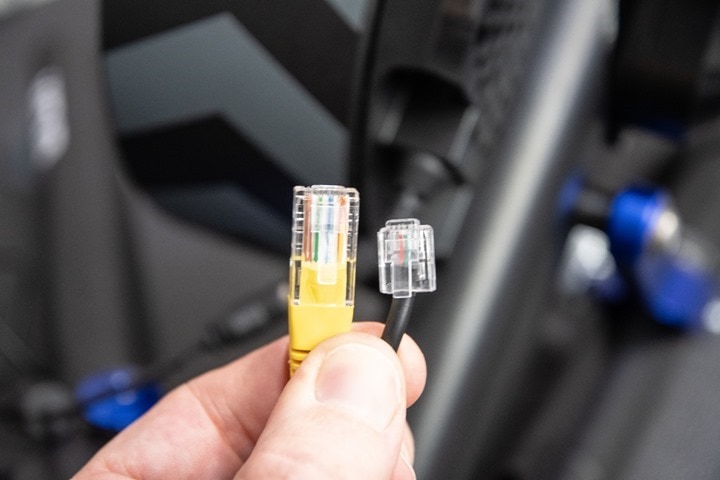
In any event, in my testing of the KICKR V5 using ANT+ & Bluetooth Smart, I used Zwift and TrainerRoad as my two main apps (which are the two main apps I use personally), as well as a side dish of The Sufferfest (which, Wahoo owns now). In the case of Zwift, I used it in regular riding mode (non-workout mode, aka SIM mode). Whereas in the case of TrainerRoad I used it in a structured workout mode (ERG mode). I dig into the nuances of these both within the power accuracy section.
Starting with Zwift, you can see the Wahoo KICKR listed as not just a controllable trainer, but also within the regular power meter and cadence section. You’ll want to pair it up as a controllable trainer (which will also pair it as a power meter) – as seen above.

In Zwift, it easily handled the rollers of the tough Titans’s Groove route on Watopia. While not physically demanding for most people, it’s a very challenging course for most trainers since it’s got nice flat sections (for high flywheel speed testing) at the beginning, followed by constant shifting rollers up into the mountains/hills, and then back down onto the flats to round out the loop. It’s perfect for seeing how quickly a trainer reacts.

Meanwhile, you’’ll see the trainer enumerated in a fairly similar manner on TrainerRoad as well:

Also, TrainerRoad’s tips page on using smart trainers in ERG mode, notably the ‘Gear Selection’ section:

I’d *strongly* recommend you either read that page, or just simply ensure you’re using the small ring up front: This is for ERG mode specifically, shift into the small ring to get better control. I did all of my ERG mode testing with the small chainring up front and about mid-cassette in the back without issue in either TrainerRoad or The Sufferfest. Here’s a longer workout I did on TrainerRoad:

And then another I did in The Sufferfest. First, here’s the pairing screen, where you can see the KICKR V5/2020 listed:

And then mid-workout cookin’ along:

As far as calibration goes, you can pretend to do calibration from just about any app.
However, as noted above – this is mostly just for show. One of the new features of the KICKR 5 (2020) is the zero calibration concept. While it’s not quite like the KICKR Bike or Tacx NEO in terms of not being possible at all to calibrate, Wahoo says there is no reason to calibrate it. So much so in fact that Wahoo will quietly override any calibration values it takes within a minute or two using a new continuous calibration system. Aside from general accuracy, this updated system eliminates various ways that people could tweak older KICKR units to boost power numbers for cheating in Zwift or other online races (even in major in-person events). The new behind the scenes continuous calibration looks at factors like temperature but also how the unit responds over the lifetime of the trainer to, according to Wahoo, ensure that it’s properly keeping itself in check even thousands of kilometers down the virtual road.

Calibration aside, Wahoo has their own app for validating various settings within the KICKR, as well as toggling a handful of settings related to how the trainer functions in apps. To access these, you’ll download the Wahoo app on iOS or Android. Once in the app you’ll add a new sensor, which is your KICKR:


If you’ve just unboxed it, you’ll probably be offered a firmware update, which you should most definitely go ahead and do, since it’ll undoubtedly solve some issues I ran into over the course of this review. Updates take about 2-5 minutes depending on whether or not your KICKR is feeling speedy.



In addition to this, there’s two other notable features. First is the ability to use an external power meter to control your KICKR. In essence this makes your trainer match your power meter. I very rarely recommend this (almost never), since it usually results in poor responsiveness. Plus, my general feeling here is that if either your trainer or power meter is so horribly off that this matters, then you should probably address that first. In the case of the KICKR, I’m not seeing issues with accuracy, so I really wouldn’t recommend this.

The second feature is ERG Mode Power Smoothing. This basically fakes what the power data looks like in ERG mode (such as in TrainerRoad or Sufferfest). Sure, Wahoo would say that it’s not faked and just heavily smoothed, but no matter, it basically makes everything look perfectly smooth rather than the reality of human and trainer fluctuations. I turn it off (it’s on by default) for all my testing, because otherwise I can’t compare actual accuracy.

Beyond this you can see the serial number, firmware version, hardware version, and ANT+ ID of your trainer. And in the event your working on a support case with Wahoo, for troubleshooting they can also enable remote diagnostics of the trainer, which sounds kinda nifty:



Finally, Wahoo’s own app can be used to control the trainer and record basic workouts. In fact, the Wahoo app is still one of the most widely compatible and data driven apps out there for simply recording a workout (even an outside one). It’ll happily pair to all your sensors, and then save files and upload them to piles and piles of 3rd party platforms.
While I rarely use the app indoors, I do occasionally use it for random tests. In fact, even Strava recommends it as an alternative to their own app after they killed off sensor support last fall.
You can control the trainer in a number of ways, including in ERG mode (setting a wattage point), incline/gradient mode (setting a % grade), and level mode (setting a specific level). You can’t have it automatically execute a structured workout for you, though you can do that with 3rd party apps as outlined, or bike GPS computers like the Wahoo ELEMENT/BOLT/ROAM, by pairing the KICKR as a smart trainer:

Aside from validating that the most recent firmware properly connects to the app and records data (it does), I didn’t use the ROAM to control the KICKR on any workouts. I think that by and large the vast majority of people are using various 3rd party platforms like TrainerRoad, Sufferfest, Zwift, or others to execute structured workouts.
Power Accuracy Analysis:

As usual, I put the trainer up against a number of power meters to see how well it handled everything from resistance control accuracy, to speed of change, to any other weird quirks along the way.
In my case I used one primary bike set up in the following configuration :
Canyon Bike Setup #1: PowerTap P2 Dual-sided pedals, Quarq DZero crankset
Canyon Bike Setup #2: Favero Assioma Dual-sided pedals Set #1, Quarq DZero crankset
Canyon Bike Setup #3: Favero Assioma Dual-sided pedals Set #2, Quarq DZero crankset
This is all in addition to the trainer itself. Note that because you remove the rear wheel I can’t use something like a PowerTap hub to compare as well (which I would use in power meter testing normally).
In any case, I was looking to see how it reacted in three core apps: Zwift (Apple TV), TrainerRoad (Bluetooth Smart on iPad), and The Sufferfest (Bluetooth Smart). The actual apps don’t typically much matter, but rather the use cases are different. In Zwift you get variability by having the road incline change and by being able to instantly sprint. This reaction time and accuracy are both tested here. Whereas in TrainerRoad and The Sufferfest I’m looking at its ability to hold a specific wattage very precisely, and to then change wattages instantly in a repeatable way. There’s no better test of that than 30×30 repeats (30-seconds at a high resistance, followed by 30-seconds at an easy resistance).
There’s two ways to look at this. First is how quickly it responds to the commands of the application. So for that, we need to actually look at the overlay from TrainerRoad showing when it sent the command followed by when the KICKR achieved that level. Here’s the levels being sent (the blue blocks)) by TrainerRoad (in this case via Bluetooth Smart on iPad) and how quickly the KICKR responded to it:

In general, when it comes to ERG mode ‘accuracy’, I’m actually looking at three specific things:
A) Base power accuracy: Is the power measurement aspect correct?
B) Power Responsiveness: How quickly can it achieve a given set point (e.g. how long to go from 150w to 450w?)
C) Power Stability: How stable is it in holding a given ERG mode setting?
So, looking at the KICKR 2020, the simple answer to all of those is: Pretty darn good in most cases.
For example, on responsiveness, it was taking about 3-4 seconds to go from 150w to 456w, pretty consistently for most – virtually identical to the just released Elite Direto XR two weeks ago. In some cases I might prefer 2-3 seconds (for both), but I’m not going to quibble too much there.

The next bit is stability. In the case of the above workout, it was after doing a Sufferfest 45 minute workout of relatively hard riding (I’m not sure why I always do these after my hard workouts, but…at least I’m warmed up). In any event, I was still pretty stable on most of them, and you see that the KICKR was pretty stable overall here. For these ones, as noted I was in the small chainring upfront, and precisely mid-cassette in the back.

There was one interval where it achieved the change in 2 seconds, and inversely another one where it took five seconds (as seen above). But the average was 3-4 seconds.
So what about actual power accuracy then? Meaning – how does it compare to other power meters? For that here’s a comparison with a Quarq DZero and Favero Assioma power meters (data set here):

A quick glance shows that the KICKR5 & Quarq DZero were exactly where I’d want them – with the KICKR being slightly lower than the Quarq DZero (due to drivechain losses). On this ride the Favero Assioma pedals were a bit lower than I’d like to see (by about 10w in most sets). After digging a bit deeper in that set the left pedal was reading abnormally low, bringing the total power down. I’ll troubleshoot that…another day.
Nonetheless, if we zoom in on a few sets we’ll see the three units agree very closely (save the Favero under-reporting slightly), but with the KICKR/Quarq relationship nailed correctly (again, with KICKR correctly being a couple watts below the Quarq).

Everything is super silky there on power, and if we look at cadence, that looks close, but not perfect. The KICKR seems to be about 2-3RPM high in many sections. Hardly a massive deal, and there were no dropouts or major issues. But just something to point out.

Next, let’s look at a Zwift ride, this one compared against the PowerTap P2 pedals and a Quarq DZero. It’s a blend of different terrain in Zwift, to the Volcano, up it, and then back to town. You can see the variability in power efforts as a result. Here’s that data set:

Now, at a high level it looks pretty darn close, right?
Sorta. See, I took a glance at the mean-max graph, which plots time and power relationships. It’s a great way to quickly see why something might not align. It doesn’t tell the whole picture, but rather gives areas to go investigate. And in this case I noticed the KICKR spiked above the rest for shorter duration surges.

And so back into the main power graph to check out some of these surges. Now, I wouldn’t call them sprints. No, these were just moderate increases in intensity, usually between 300-400w, sometimes 500w. And you can see the KICKR peaking out over the top. Sometimes quite significantly, sometimes just barely.

And again here, in this first case by some 75w, and then repeatedly through this two minute random snippet by just a touch – 10-15w in most cases.

So, fast forward a few weeks to a newer firmware version (the one the KICKR is launching today on), and while the issue is slightly less than before, it still exists in this data set from another Zwift ride:

In addition, it also introduced a seemingly new issue around low-cadence. While I rarely pedal at 50RPM, for whatever reason I was doing so with my then-shot legs during a climb. And that caused the power to actually increase dramatically:

You can see below the cadence graph for the same section. As my cadence dropped, so did accuracy. And as cadence increased, so did accuracy.

Note that the surges also are present in two other Zwift rides I did over the last three weeks, with roughly the same intensity. The less you surge (steady-state riding for example), the less the issue is. Whereas the more you surge (races with group dynamics), the more obvious the issue is. I’ve also tested it across three different sets of power meters.
Wahoo says they’re looking into both of these issues and plan to find solutions for future firmware updates. If you turn back the history machine, this sort of initial launch inaccuracy around surges isn’t uncommon for Wahoo trainers. In fact, I saw it the first month or two in the KICKR CORE as well as the KICKR SNAP. Hopefully it’s just a short-lived issue. Though, in the meantime, I suppose it’s great for folks in a race, since every minor surge gets you free power.
Finally, we’ll finish on The Sufferfest, which is an ERG mode workout I did last night. Here’s that data set:

This, as one can see above quite plainly, included boatloads of massive resistance changes. Also, I forgot to start the Fenix 6 recording the Favero Assioma during the warm-up, though I did double-record it on another Edge 530. But that showed a few dropouts later in the workout, so I skipped showing that above to keep it easier to read (but the data is available in the linked set above).
In any case, this all looks just fine and dandy when zoomed in:

Responsiveness on this workout was great, exactly where I’d want things to feel, though, the Sufferfest app often held onto the higher power intensity about 1-2 seconds after the interval ended before releasing to a rest brake. Some apps will basically send the command a second or two early, such that the timing ends up perfect, but that didn’t seem to be the case here (or, the commands weren’t being received). It wasn’t all the time, but it was definitely obvious a few times.
Still, that app quirk aside, these all look great:

Though, as with all my other tests on the KICKR5, cadence needs a bit of work still. It’s very often off by 2-3RPM. Again, not a huge deal, but of note:

OK – so where do we stand?
Well, so-so. As of launch, the accuracy here is clearly less than the KICKR2018 (since that doesn’t suffer from the surge overcommit issue, nor minor cadence offset accuracy issue). Nor does it suffer from the low-cadence power accuracy issue.
Are these major show-stopper issues? Probably not long term. Wahoo has a pretty consistent track record of quickly iterating through early accuracy teething pains on their trainers, usually quickly eliminating them in subsequent firmware updates. But ultimately, I can’t predict if/when that firmware update will come. I suspect most people probably won’t care (heck, some might even like the extra power boost).
Note that these power accuracy issues don’t appear in ERG mode (structured workout mode). So if you’ve got TrainerRoad or Sufferfest or such, then these are non-issues for you, best I can tell.
In any event, once a firmware update comes I’ll re-test and see if it resolves the issues.
(Note: All of the charts in these accuracy portions were created using the DCR Analyzer tool. It allows you to compare power meters/trainers, heart rate, cadence, speed/pace, GPS tracks and plenty more. You can use it as well for your own gadget comparisons, more details here.)
Trainer Comparison:
I’ve added the Wahoo KICKR 5 (2020) into the product comparison database. This allows you to compare it against other trainers I’ve reviewed. For the purposes of this particular table, I’ve compared it against the Tacx NEO 2T, Elite Direto XR, and Saris H3 (basically the top trainers from each major company). You can also mix and match and create your own trainer comparison charts with just about any trainer on the market in the aforementioned/linked product database.
| Function/Feature | Wahoo KICKR V5/2020 (Current Version) | Elite Direto XR | Saris H3 (CycleOps Hammer 3) | Tacx NEO 2 Smart |
|---|---|---|---|---|
| Copyright DC Rainmaker – Updated August 11th, 2020 @ 7:03 amNew Window Expand table for more results | ||||
| Price for trainer | $ 1,199 | $ 949 | $ 999 | $ 999 |
| Trainer Type | Direct Drive (No Wheel) | Direct Drive (No Wheel) | Direct Drive (no wheel) | Direct Drive (no wheel) |
| Wired or Wireless data transmission/control | Wireless + Upcoming Wired Ethernet Adapter | Wireless | Wireless | Wireless |
| Power cord required | Yes | Yes (no control w/o) | Yes | No |
| Flywheel weight | 16lbs/7.25kgs | 5.1KG/11.2LBS | 20lb/9kg | Simulated/Virtual 125KG |
| Includes cassette | Yes (11 Speed SRAM/Shimano) | Yes (11 Speed SRAM/Shimano) | No | No |
| Includes motor to drive speed (simulate downhill) | No | No | No | Yes |
| Maximum wattage capability | 2,200w @ 40KPH | 2,300w @ 40KPH | 2,000w | 2,200w @ 40KPH |
| Maximum simulated hill incline | 20% | 24% | 20% | 25% |
| Measures/Estimates Left/Right Power | No | 9EUR one-time fee | No | Yes |
And again, remember you can mix and match and compare against all trainers I’ve reviewed in the product comparison database here.
Summary:

At this point, the KICKR V5 (2020) is essentially a minor update to the hardware that ensures Wahoo keeps roughly on-cycle for updating their marquee trainer. Historically, Wahoo has rarely done major updates of the KICKR series, instead preferring for more frequent minor updates. In this case, the changes are indeed pretty minimal – at least until Wahoo releases the wired ethernet network accessory for those that suffer from connectivity issues.
On the new Axis feet, I just don’t see them providing a meaningful change compared to a simple trainer mat. Which isn’t to say they’re bad – not at all. Anything that increases comfort, especially for longer rides – even incrementally – is appreciated. But after numerous rides on the trainer, I simply can’t tell the difference when atop a trainer mat. When directly placed on a concrete floor, the different is almost felt. Almost. Maybe? Kinda.
I do however like the idea of Wahoo moving away from a spin-down calibration on their trainer, which eliminates a significant way that people can skew their smart trainer accuracy in a more favorable manner (read: cheating) on Zwift or other apps in racing. While I’d love to have seen Wahoo go towards the true electromagnetic design on their KICKR Bike (like a TACX NEO Series), the existing technology they use, once a bit more polish is added, should fit the bill for now.
Until then, assuming Wahoo can sort out the accuracy issues – then the KICKR V5 will probably be just as popular as past KICKR units. I wouldn’t really recommend upgrading from a 2016 or 2018 KICKR, but if you’ve got an older one, it could be something to consider if you find the newer features useful to you.
With that – thanks for reading!
Found this review useful? Or just wanna save a bundle? Here’s how:

Hopefully you found this review useful. At the end of the day, I’m an athlete just like you looking for the most detail possible on a new purchase – so my review is written from the standpoint of how I used the device. The reviews generally take a lot of hours to put together, so it’s a fair bit of work (and labor of love). As you probably noticed by looking below, I also take the time to answer all the questions posted in the comments – and there’s quite a bit of detail in there as well.
I’ve partnered with Clever Training to offer all DC Rainmaker readers exclusive benefits on all products purchased. By joining the Clever Training VIP Program, you will earn 10% points on this item and 10% off (instantly) on thousands of other fitness products and accessories. Points can be used on your very next purchase at Clever Training for anything site-wide. You can read more about the details here. By joining, you not only support the site (and all the work I do here) – but you also get to enjoy the significant partnership benefits that are just for DC Rainmaker readers. And, since this item is more than $ 99, you get free 3-day (or less) US shipping as well.
Wahoo KICKR V5 (2020)
Wahoo KICKR AXIS Feet
Wahoo CLIMB
Wahoo KICKR DESK
Wahoo Headwind Fan
For European/Australian/New Zealand readers, you can also pickup the unit via Wiggle at the links below, which helps support the site too! With Wiggle new customers get 10GBP (or equivalent in other currencies) off their first order for anything over 50GBP by using code [Currently Disabled] at check-out after clicking the links below.
Wahoo KICKR V5 (2020) (EU/UK/AU/NZ – Wiggle) – COMING SOON
Wahoo CLIMB (EU/UK/AU/NZ – Wiggle)
Wahoo KICKR DESK (EU/UK/AU/NZ – Wiggle)
Wahoo Headwind Fan (EU/UK/AU/NZ – Wiggle)
And finally, here’s a handy list of accessories that most folks getting a trainer for the first time might not have already:
| Product | Amazon Link | Note | |
|---|---|---|---|
 |
Basic Trainer Mat | Amazon | This is a super basic trainer mat, which is exactly what you’ll see me use. All it does is stop sweat for getting places it shouldn’t (it also helps with vibrations too). |
 |
Front Wheel Riser Block | Amazon | Here’s the thing, some people like front wheel blocks, some don’t. I’m one of the ones that do. I like my front wheel to stay put and not aimlessly wiggle around. For $ 8, this solves that problem. Note some trainers do come with them. Also note, I use a riser block with *every* trainer. |
 |
Honeywell HT-900 Fan | Amazon | I’ve got three of these $ 12 fans floating around the DCR Cave, and I frequently use them on rides. They work just fine. Sure, they’re not as powerful as a Wahoo Headwind, but I could literally buy 20 of them for the same price. |
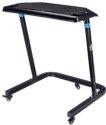 |
RAD/Lifeline Cycle Trainer Desk | Amazon | So here’s the thing – this desk is both a knock-off of the KICKR Desk, but also better than it. First, it’s got wheel locks (so the darn thing stays put), and second, it has two water bottle holders (also useful for putting other things like remotes). I’ve been using it as my main trainer desk for a long time now and love it. Cheaper is better. Note: Branding varies by country, exact same desk. |
 |
Tacx Tablet Bike Mount | Amazon | I’ve had this for years, and use it in places where I don’t have a big screen or desk, but just an iPad or tablet on my road bike bars. |
Additionally, you can also use Amazon to purchase the unit (though, no discount/points). Or, anything else you pickup on Amazon helps support the site as well (socks, laundry detergent, cowbells). If you’re outside the US, I’ve got links to all of the major individual country Amazon stores on the sidebar towards the top.
Thanks for reading!

